National personification
A national personification is an anthropomorphic personification of a nation or its people. It may appear in political cartoons and propaganda. As a personification it cannot be a real person, of the Father of the Nation type, or one from ancient history who is believed to have been real.
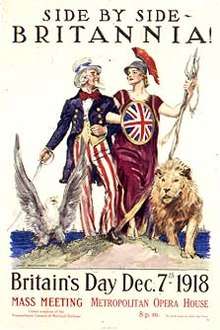
.jpg)

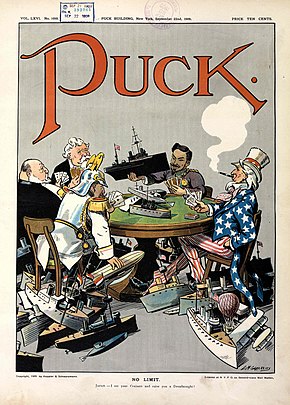
Some early personifications in the Western world tended to be national manifestations of the majestic wisdom and war goddess Minerva/Athena, and often took the Latin name of the ancient Roman province. Examples of this type include Britannia, Germania, Hibernia, Helvetia and Polonia. Examples of personifications of the Goddess of Liberty include Marianne, the Statue of Liberty (Liberty Enlightening the World), and many examples of United States coinage. Another ancient model was Roma, a female deity who personified the city of Rome and more broadly, the Roman state, and who was revived in the 20th Century as the personification of Mussolini's "New Roman Empire". Examples of representations of the everyman or citizenry in addition to the nation itself are Deutscher Michel, John Bull and Uncle Sam.[1]
Personifications by country or territory
| Country | Image | Personification | Animal used for the same purpose |
|---|---|---|---|
| Mother Albania (Nëna Shqipëria) | |||
%2C_Johann_Joachim_Kaendler_and_assistants%2C_Meissen_Porcelain_Factory%2C_c._1760%2C_hard-paste_porcelain_-_Wadsworth_Atheneum_-_Hartford%2C_CT_-_DSC05373.jpg) |
Personification of the Americas | ||
 |
Effigy of the Republic/Liberty/Progress/Fatherland, Gaucho | ||
 |
Mother Armenia (Mayr Hayastan; lit. "Mother Hayastan") | ||
 |
Phoebus, Little Boy from Manly | Boxing kangaroo | |
 |
Austria (Personification) | ||
| Bengal tiger.[2] | |||
 |
La Belgique or Belgica. | Leo Belgicus | |
 |
Efígie da República; the Bandeirante (only in São Paulo State); the Candango (in Brasília); the Gaúcho (in Rio Grande do Sul) | ||
 |
Mother Bulgaria | ||
| Preah Thong and Neang Neak | |||
| Mountie,[3] Johnny Canuck,[4] Le Vieux de '37 (French Canada), Canada Bereft also known as Mother Canada (at the Canadian National Vimy Memorial). Canada was often personified as a young woman in 19th and early 20th century editorial cartoons, called simply '"Canada," "Miss Canada,'" or sometimes "Mother Canada"[5] | Canadian beaver | ||
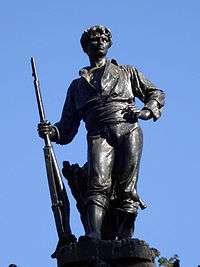 |
El Roto, El Huaso, Doña Juanita (an average Chilean woman from the countryside) | ||
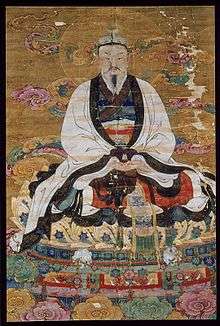 |
Jade Emperor | Chinese dragon | |
| Juan Valdez | |||
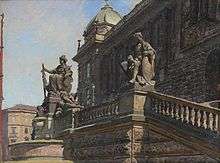 |
Čechie, Czech Vašek, Svejk. | double-tailed Czech lion | |
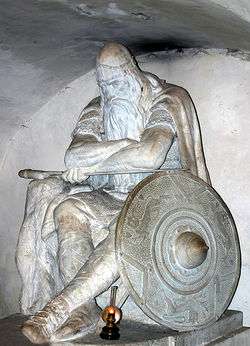 |
Holger Danske, Mor Danmark | ||
 |
Conchoprimo | ||
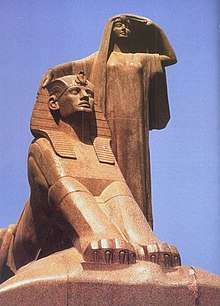 |
Mother of the World (Om El Donia) | ||
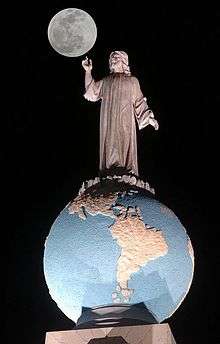 |
Monumento al Divino Salvador del Mundo | ||
.jpg) |
Europa or Europa regina | Zeus as a white bull | |
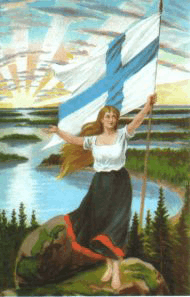 |
Finnish Maiden (Suomi-neito) | ||
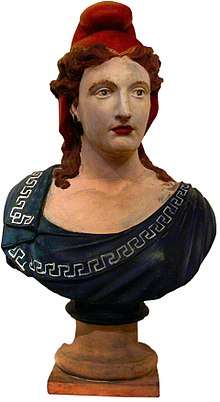 |
Marianne | Gallic rooster | |
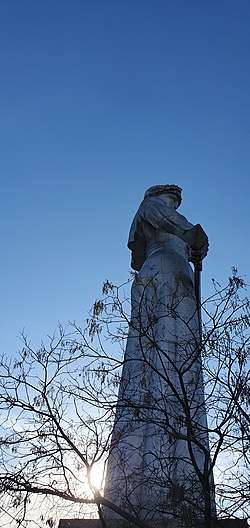 |
Georgia: "Mother of a Georgian" (Kartvlis Deda) | ||
.jpg) |
Germany: Germania, Deutscher Michel
Bavaria: Bavaria, Berlin: Berolina, Brunswick: Brunonia, Franconia: Franconia, Hamburg: Hammonia, Prussia: Borussia, Palatinate: Palatia, Saxony: Saxonia |
Reichsadler | |
.jpg) |
Hellas | ||
 |
Ezili Dantor, Katrin (based on the real life Haitian hero, Catherine Flon) | ||
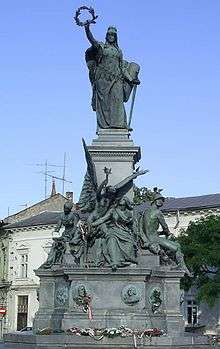 |
The Lady of Hungaria | ||
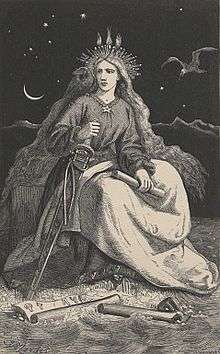 |
The Lady of the Mountains (Fjallkonan) | ||
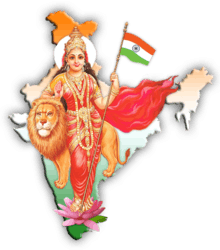 |
Bharat Mata ("Mother India") | Indian tiger, Indian elephant | |
| Ibu Pertiwi | Garuda Pancasila | ||
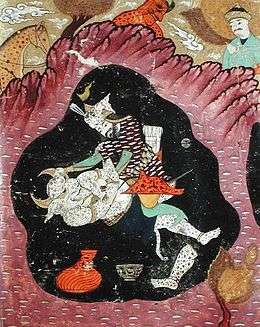 |
Rostam | ||
 |
Ériu, Banba, Fódla, Kathleen Ni Houlihan, Hibernia, The Old Woman of Beare[6] | ||
| Srulik | |||
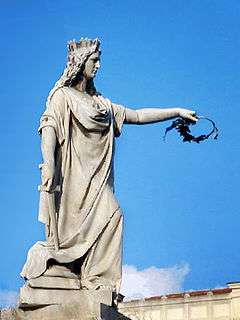 |
Italia Turrita, Roma | ||
 |
Amaterasu, Emperor Jimmu | Green Pheasant, Koi | |
| Kobylandy | |||
| Wanjiku | |||
 |
Dangun, Ungnyeo, Yangban | Korean Tiger, Chollima | |
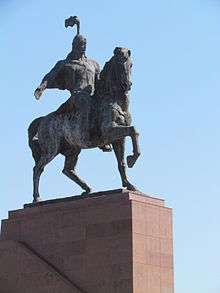 |
Manas | ||
 |
Hang Tuah[7][8] | Malayan tiger[9] | |
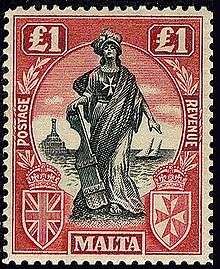 |
Melita | ||
 |
Alegoría de la Patria Mexicana (es), La China Poblana | Golden eagle | |
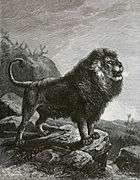 |
Barbary Lion | ||
 |
Fairy of Lovćen, Mother Montenegro | ||
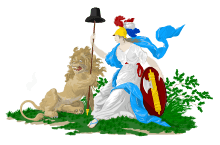 |
Dutch Maiden | Dutch Republic Lion | |
| Zealandia[10] | Kiwi | ||
| Mother Macedonia[11][12] | |||
 |
Mother Norway, stereotyp. Ola Nordmann & Kari Nordmann, hist. Nór | ||
| Pak Watan/Ali Faisal "A Term of Endearment for Pakistan," Mumlikat-e-Khudadad ('God-Given State') | Snow leopard.[13] | ||
 |
Handala | ||
.jpg) |
Libertad also known as Madre Patria (Allegory of the Peruvian Motherland) | Vicuña | |
| Ináng Bayan, Filipinas, Juan dela Cruz | Philippine Carabao | ||
 |
Polonia | White eagle | |
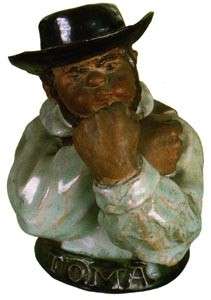 |
Zé Povinho, Eu nacional (National Self), Republic effigy, Guardian Angel of Portugal | ||
 |
România | ||
 |
Mother Russia/Mother Motherland | Russian bear | |
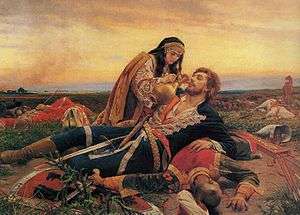 |
Mother Serbia, Kosovo Maiden | ||
| Merlion | |||
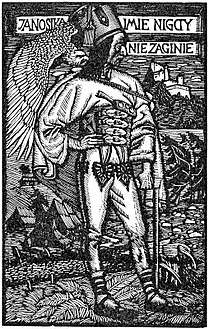 |
Jánošík | ||
| Kralj Matjaž ("King Matjaž", a legendary king in Slovenia and some other nations), Peter Klepec | |||
_03b.jpg) |
Hispania | ||
| Sri Lanka Matha | |||
| Mama Sranan (Mother Suriname), a 1965 sculpture by Jozeph Klas in the center of Paramaribo, of a mother figure holding five children representing Suriname's ethnic groups in her arms.[14] | |||
| Mother Svea, Svenne Svensson | |||
.jpg) |
Helvetia | ||
 |
Siam Devadhiraj (พระสยามเทวาธิราช "The guardian angel of Siam"), Thailand | White elephant | |
| Koroghlu | |||
.jpg) |
Cossack Mamay | ||
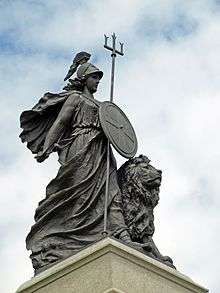 |
Britannia (United Kingdom), John Bull (England), Dame Wales (Wales) | The Lion and the Unicorn (England and Scotland), Bulldog (United Kingdom), Welsh dragon (Wales) | |
 |
Uncle Sam (government personification), Lady Liberty, Columbia, Johnny Reb (The South, obsolete), Billy Yank (The North, obsolete), Brother Jonathan (New England, obsolete) | Bald Eagle, Timber rattlesnake (American Revolution, obsolete) | |
 |
Personification of Uruguay | ||
| The Four Immortals, Hùng King | |||
See also
- Afghanis-tan, a manga originally published as a webcomic about Central Asia with personified countries.
- Polandball, a contemporary form of national personification in which countries are drawn by Internet users as stereotypic balls and shared as comics on online communities.
- Hetalia: Axis Powers, an anime about personified countries interacting, mostly taking place within the World Wars.
- Mural crown
- National animal, often personifies a nation in cartoons.
- National emblem, for other metaphors for nations.
- National god, a deity that embodies a nation.
- National patron saint, a Saint that embodies a nation.
References
- Eric Hobsbawm, "Mass-Producing Traditions: Europe, 1870-1914," in Eric Hobsbawm and Terence Ranger, eds., The Invention of Tradition (Cambridge, 1983), 263-307.
- "NATIONAL SYMBOLS". Bangladesh Tourism Board. Bangladesh: Ministry of Civil Aviation & Tourism. Archived from the original on 2016-12-28. Retrieved 2015-09-10.
- McGill, Robert (2017). War Is Here: The Vietnam War and Canadian Literature. McGill-Queen's Press. p. 37. ISBN 9780773551589. Retrieved 17 May 2019.
- Barber, Katherine (2007). Only in Canada You Say: A Treasury of Canadian Language. Oxford University Press Canada. p. 70. ISBN 9780195427073.
- "Library and Archives Canada".
- O'Rourke Murphy, M. & MacKillop, J. (2006). An Irish Literature Reader: Poetry, Prose, Drama.
- Liok Ee Tan (1988). The Rhetoric of Bangsa and Minzu. Monash Asia Institute. p. 14. ISBN 978-0-86746-909-7.
- Melanie Chew (1999). The Presidential Notes: A biography of President Yusof bin Ishak. Singapore: SNP Publications. p. 78. ISBN 978-981-4032-48-3.
- Minahan, James B. (2009). The Complete Guide to National Symbols and Emblems. Greenwood. p. 101. ISBN 978-0313344961.
- https://teara.govt.nz/en/photograph/32532/south-african-war-memorial-waimate
- "A Manifesto from the Provisional Government of Macedonia". 1881.
Our mother Macedonia became now as a widow, lonely and deserted by her sons. She does not fly the banner of the victorious Macedonian army
Cite journal requires|journal=(help) - Bulgarian graphic representation of Bulgaria, East Rumelia and North Macedonia
- "The Official Web Gateway to Pakistan". www.pakistan.gov.pk. Archived from the original on 2016-11-28. Retrieved 2016-10-23.
- "Archived copy". Archived from the original on 2016-04-14. Retrieved 2016-03-30.CS1 maint: archived copy as title (link)
Further reading
- Lionel Gossman. "Making of a Romantic Icon: The Religious Context of Friedrich Overbeck's 'Italia und Germania.'" American Philosophical Society, 2007. ISBN 0-87169-975-3.
External links
| Wikimedia Commons has media related to Personifications of nations. |
